Last Updated: July 2025
"Golf is too expensive for me."
It's the assumption that keeps millions of people from trying golf. You've heard the stories about $500 green fees, $2,000 club sets, and exclusive country clubs that cost more than a car.
But here's what the golf industry doesn't want you to know: You can play quality golf for the same cost as going to movies twice a month.
After analyzing golf costs across the country and helping hundreds of beginners start playing on realistic budgets, I can tell you that golf's "expensive" reputation is mostly myth.
Yes, golf CAN be expensive if you choose the premium options, but it doesn't have to be.
The reality: You can start playing golf for under $300 and enjoy regular rounds for $25-40 each. The key is understanding where to spend, where to save, and how to budget for golf without breaking the bank.
In this complete cost breakdown, you'll discover:
- Realistic startup costs for beginning golfers (under $500)
- Monthly golf expenses that fit any budget
- Where golf gets expensive (and how to avoid those traps)
- Money-saving strategies that don't compromise the experience
- Regional cost differences across the United States
- How golf costs compare to other recreational activities
Let's break down the real numbers and show you how to enjoy golf without emptying your wallet.
The Real Cost of Starting Golf
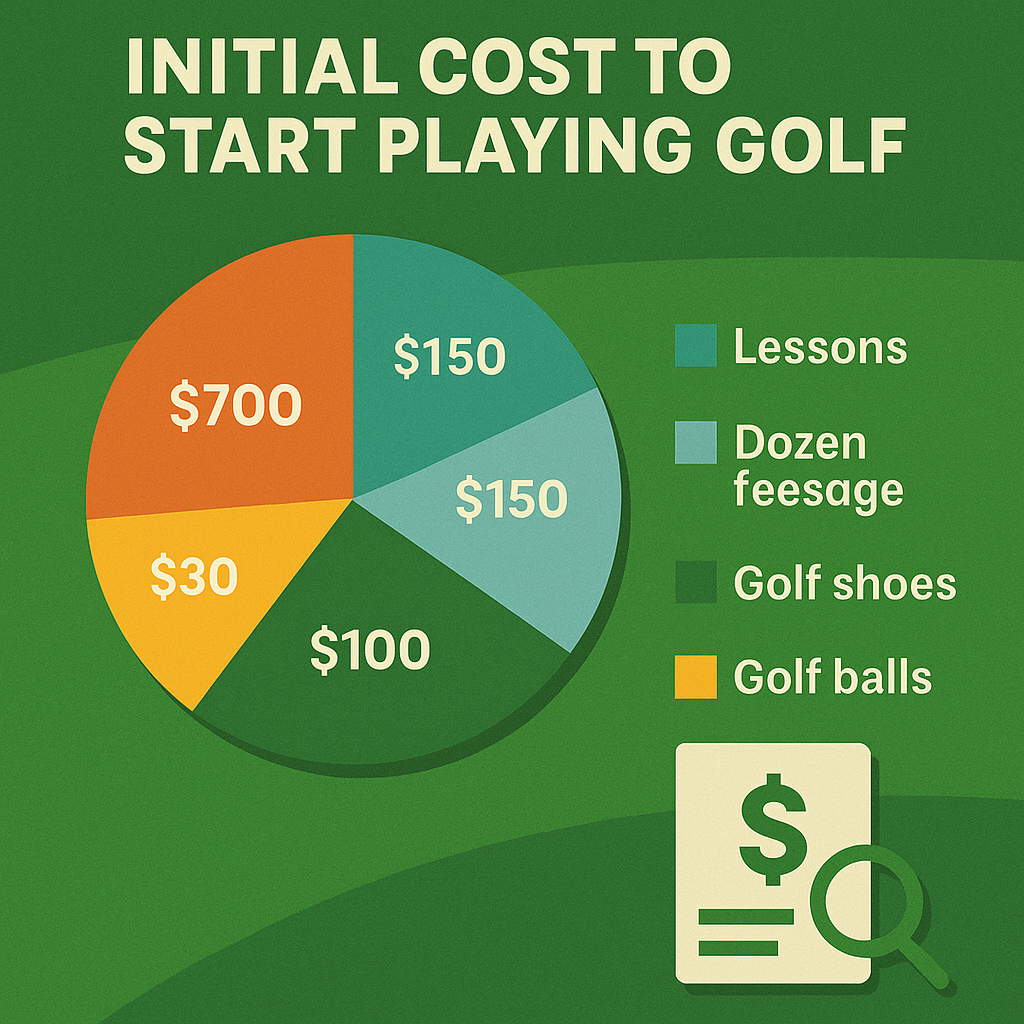
Essential Startup Costs
Minimum Investment to Start Playing:
Equipment (One-Time Costs):
- Basic club set: $200-400
- Golf bag: $50-100
- Golf balls (2 dozen): $20-40
- Tees and accessories: $20-30
- Golf glove: $15-25
- Golf shoes: $60-120
- Total Equipment: $365-715
First Round Costs:
- Green fees (municipal course): $25-45
- Cart rental: $15-25
- Range balls (warm-up): $5-8
- Total First Round: $45-78
Realistic Startup Budget: $410-793 to start playing golf
Budget vs. Premium Startup Comparison
Startup Cost Comparison
Bare Minimum Budget ($350):
- Used club set: $150
- Basic bag: $40
- Starter accessories: $30
- Municipal course round: $35
- Walk instead of cart: $0
- Total: $255 + ongoing rounds
Comfortable Budget ($600):
- New beginner set: $350
- Quality bag: $80
- Complete accessories: $50
- Nice public course: $45
- Cart included: $20
- Total: $545 + ongoing rounds
Premium Start ($1,200):
- High-end clubs: $800
- Premium bag: $150
- Top accessories: $100
- Resort course: $85
- Premium cart: $30
- Total: $1,165 + ongoing rounds
According to National Golf Foundation data, the average beginner spends $587 on initial equipment, which aligns with our "comfortable budget" recommendation.
Ongoing Monthly Golf Costs
Typical Monthly Expenses
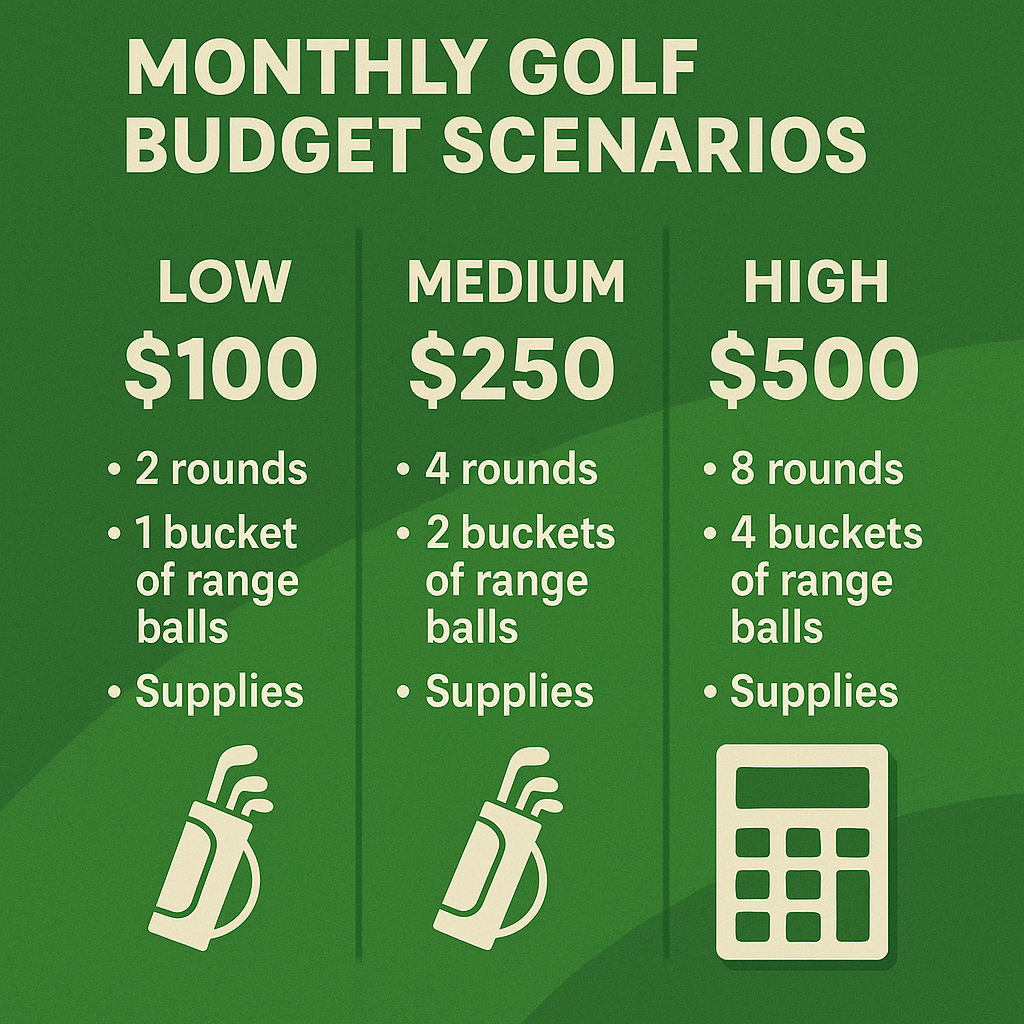
Casual Golfer (2 rounds/month):
- Green fees: $50-90 (2 x $25-45)
- Cart rentals: $30-50 (2 x $15-25)
- Range practice: $20-30 (4 sessions)
- Golf balls: $10-20 (replacing lost balls)
- Total Monthly: $110-190
Regular Golfer (4 rounds/month):
- Green fees: $100-180 (4 x $25-45)
- Cart rentals: $60-100 (4 x $15-25)
- Range practice: $40-60 (8 sessions)
- Golf balls/accessories: $20-30
- Total Monthly: $220-370
Avid Golfer (8 rounds/month):
- Green fees: $200-360 (8 x $25-45)
- Cart rentals: $120-200 (8 x $15-25)
- Range practice: $60-100 (12 sessions)
- Equipment maintenance: $30-50
- Total Monthly: $410-710
Cost-Per-Round Analysis
Municipal Courses:
- Green fees: $25-45
- Cart: $15-25
- Total per round: $40-70
Public Daily Fee Courses:
- Green fees: $35-65
- Cart: $18-30
- Total per round: $53-95
Semi-Private Courses:
- Green fees: $50-85
- Cart: $20-35
- Total per round: $70-120
Resort Courses:
- Green fees: $75-150+
- Cart: $25-40
- Total per round: $100-190+
Regional Cost Differences
Golf Costs by Region
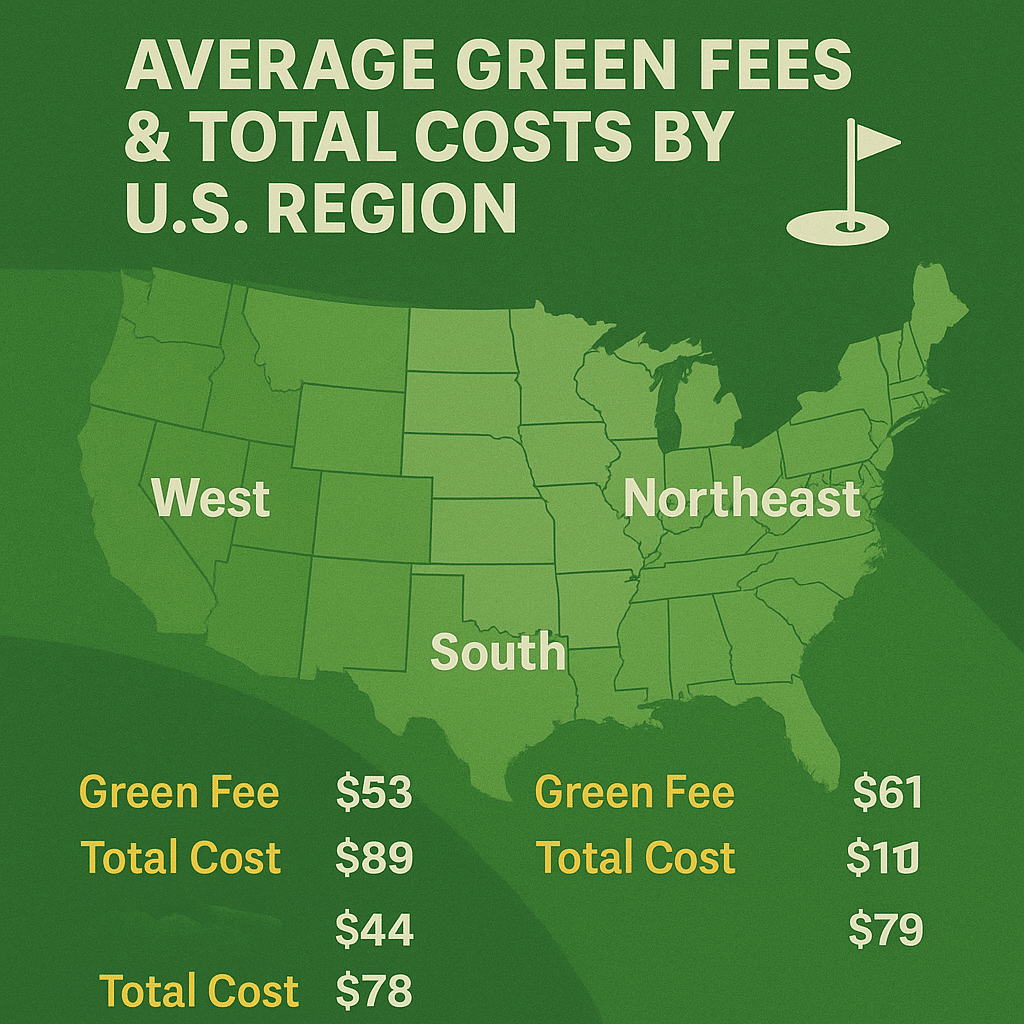
Most Affordable Golf Regions:
Midwest (Ohio, Indiana, Illinois):
- Average green fees: $28-42
- Cart rental: $14-20
- Total typical round: $42-62
Southeast (Georgia, Alabama, Tennessee):
- Average green fees: $32-48
- Cart rental: $16-22
- Total typical round: $48-70
Mountain West (Colorado, Utah, Arizona):
- Average green fees: $35-55
- Cart rental: $18-25
- Total typical round: $53-80
Most Expensive Golf Regions:
Northeast (New York, Connecticut, Massachusetts):
- Average green fees: $50-85
- Cart rental: $25-35
- Total typical round: $75-120
California (Los Angeles, San Francisco, San Diego):
- Average green fees: $55-95
- Cart rental: $25-40
- Total typical round: $80-135
Hawaii:
- Average green fees: $75-150
- Cart rental: $30-45
- Total typical round: $105-195
Urban vs. Rural Cost Differences
Rural/Small Town Golf:
- Pros: Lower green fees, less crowded, relaxed atmosphere
- Cons: Fewer course options, potentially lower maintenance
- Average savings: 30-50% compared to urban areas
Urban/Metropolitan Golf:
- Pros: More course variety, better facilities, convenient location
- Cons: Higher prices, more crowded, competitive tee times
- Premium cost: 50-100% higher than rural areas
Where Golf Gets Expensive (And How to Avoid It)
The Big Money Traps
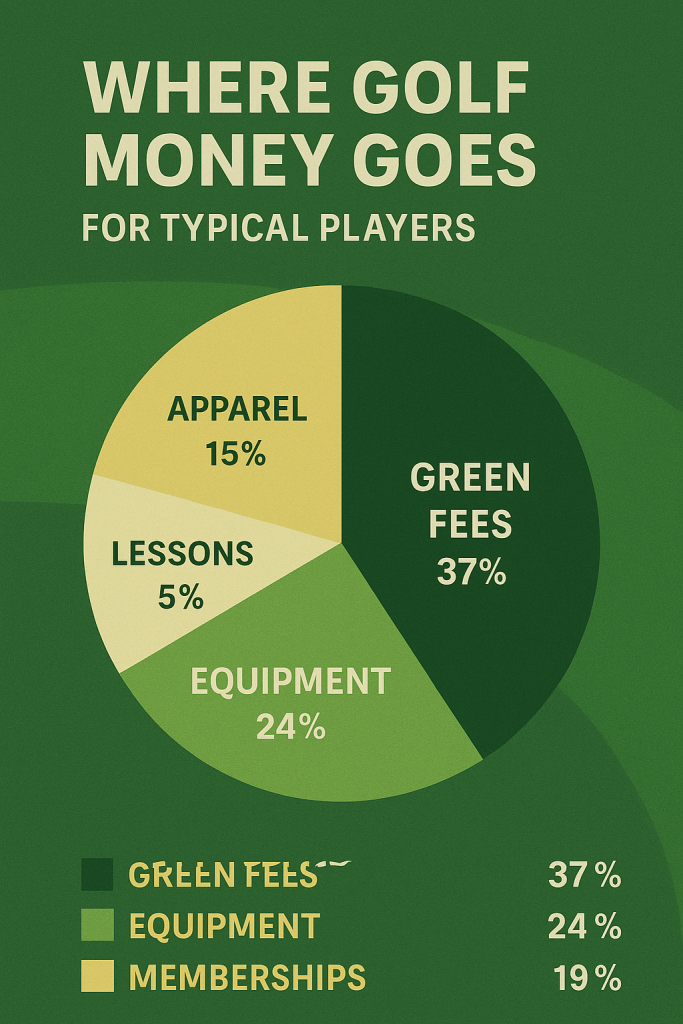
Equipment Trap:
- The problem: Constantly upgrading clubs
- Cost impact: $500-2000+ annually
- Solution: Buy quality once, resist marketing hype
Premium Course Trap:
- The problem: Only playing expensive resort courses
- Cost impact: $50-100 extra per round
- Solution: Mix premium rounds with affordable options
Lesson Trap:
- The problem: Endless lessons without practice
- Cost impact: $75-150 per lesson, 10+ lessons annually
- Solution: Take a few quality lessons, then practice extensively
Accessory Trap:
- The problem: Buying every new golf gadget
- Cost impact: $200-500+ annually
- Solution: Focus on essentials, avoid impulse purchases
Hidden Costs Beginners Don't Expect
Course-Related:
- Pace of play fees: Some courses charge extra for slow play
- Peak time premiums: Weekend and prime time surcharges
- Cancellation fees: Weather or last-minute changes
- Replay fees: Playing additional rounds same day
Equipment-Related:
- Club repairs: Broken shafts, bent clubs
- Grip replacements: $8-15 per grip annually
- Ball losses: Beginners lose 3-6 balls per round initially
- Shoe replacements: Golf shoes wear out with regular use
Travel-Related:
- Gas money: Driving to various courses
- Food and drinks: On-course dining costs
- Lodging: Golf trips and destination play
- Tournament fees: Entry fees for competitions
Money-Saving Strategies That Work
Equipment Savings
Buy Smart, Not Expensive:
- Used equipment: Save 40-60% on barely used clubs
- Previous year models: 20-30% savings when new models release
- Complete sets: Better value than individual clubs for beginners
- Demo clubs: Pro shops often sell demo clubs at discount
Recommended Money-Saving Equipment Sources:
- 2nd Swing Golf: Certified pre-owned with warranty
- Golf Galaxy Trade-In: Store credit for upgrades
- Local pro shops: Often have quality trade-ins
- End-of-season sales: 30-50% off in fall/winter
Playing Savings
Course Selection Strategies:
- Municipal courses: City-owned, taxpayer-subsidized
- Twilight rates: 30-50% off after 2-4 PM
- Walking rates: Save $15-25 by not using cart
- Off-peak times: Weekday discounts
Membership and Package Deals:
- Course memberships: Break even at 15-20 rounds annually
- City golf passes: Municipal course discounts
- Group packages: Foursome deals and corporate rates
- Season passes: Unlimited play at specific courses
Apps and Websites for Deals:
- GolfNow: Last-minute tee time discounts
- TeeOff: Hot deals and package rates
- Supreme Golf: Regional discount programs
- Course websites: Direct booking often cheapest
Pro Money-Saving Tips
Play Municipal Courses: Often 40-60% cheaper than private daily fee Walk When Possible: Save $15-25 per round on cart fees Bring Your Own Water/Snacks: Avoid $15-25 on-course food markups Buy Lost Balls: Practice-quality balls for $10-15 per dozen Share Equipment Initially: Borrow clubs while learning
Golf vs. Other Recreation Costs
Cost Comparison Analysis
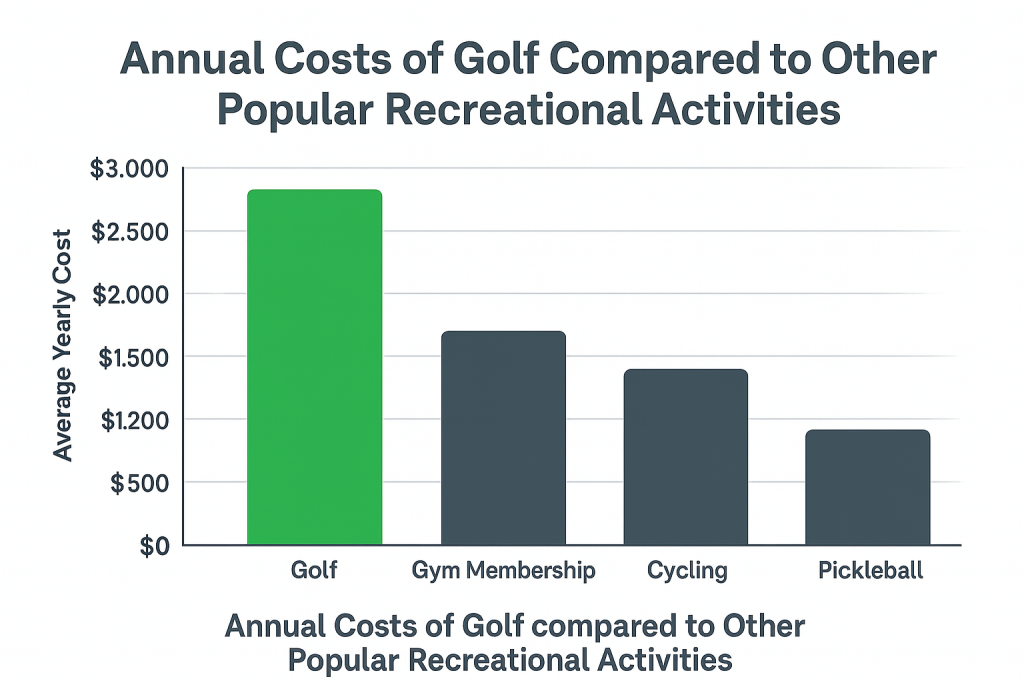
Annual Recreation Costs (Regular Participation):
Golf (24 rounds/year):
- Equipment amortized: $100-150
- Green fees and carts: $1,200-2,280
- Accessories and maintenance: $150-300
- Total Annual: $1,450-2,730
Skiing (20 days/year):
- Equipment/rentals: $300-800
- Lift tickets: $1,000-2,000
- Lodging and travel: $800-2,000
- Total Annual: $2,100-4,800
Boating (Season ownership):
- Boat payment/maintenance: $3,000-8,000
- Fuel and marina fees: $1,500-3,000
- Insurance and registration: $500-1,200
- Total Annual: $5,000-12,200
Gym + Personal Training:
- Gym membership: $600-1,200
- Personal training: $2,400-4,800
- Equipment and supplements: $300-600
- Total Annual: $3,300-6,600
Movie Theater (Weekly):
- Tickets (2 people): $1,560
- Concessions: $780
- Transportation: $260
- Total Annual: $2,600
Value Proposition Analysis
Golf's Value Advantages:
- 4+ hours of recreation per session
- Outdoor exercise and fresh air
- Social interaction and networking
- Skill development and measurable improvement
- Lifetime activity suitable for all ages
- Travel opportunities to different courses
Cost-Per-Hour Analysis:
- Golf round: $10-20 per hour of recreation
- Movie: $8-12 per hour of entertainment
- Skiing: $15-30 per hour on slopes
- Personal training: $75-150 per hour
Building Your Golf Budget
Monthly Budget Planning
Step 1: Determine Your Golf Frequency
- Casual: 1-2 rounds per month
- Regular: 3-4 rounds per month
- Avid: 6+ rounds per month
Step 2: Calculate Base Costs
- Rounds × Average green fee
- Add cart rental if needed
- Include practice range sessions
Step 3: Add Variable Costs
- Equipment maintenance: $20-40 monthly
- Ball replacement: $10-25 monthly
- Lessons (if taking): $75-150 monthly
- Travel and food: $30-75 monthly
Step 4: Set Annual Equipment Budget
- Beginners: $200-400 annually
- Improving players: $300-600 annually
- Serious golfers: $500-1,000 annually
Sample Monthly Budgets
Beginner Golf Budgets
Tight Budget ($75/month):
- 2 municipal rounds: $50
- Walking (no cart): $0
- Practice range: $15
- Ball replacement: $10
Comfortable Budget ($150/month):
- 2-3 public rounds: $90
- Cart rental: $30
- Practice and lessons: $20
- Equipment fund: $10
Enthusiast Budget ($300/month):
- 4-5 quality rounds: $200
- Cart and amenities: $50
- Lessons and practice: $30
- Equipment upgrades: $20
Seasonal Cost Considerations
Peak Season vs. Off-Season
Peak Season (Spring/Summer):
- Premium pricing: 20-40% higher green fees
- Cart requirements: Many courses require carts
- Advance booking: Premium tee times cost more
- Travel costs: Higher accommodation rates
Off-Season (Fall/Winter):
- Discount rates: 30-60% off green fees
- Twilight opportunities: Longer twilight windows
- Equipment sales: Best time to buy new gear
- Course deals: Memberships and packages discounted
Weather-Related Costs
Weather Contingencies:
- Rain checks: Course policies vary
- Seasonal equipment: Cold weather gear
- Indoor alternatives: Simulators and indoor ranges
- Travel adjustments: Destination golf in winter
Cost Management Tips by Experience Level
Beginner Cost Strategy (First Year)
Focus Areas:
- Equipment: Buy quality basics, avoid premium upgrades
- Courses: Stick to beginner-friendly, affordable options
- Lessons: Invest in 3-5 quality lessons maximum
- Practice: Use practice facilities efficiently
Budget Allocation:
- Equipment (one-time): 60% of first-year budget
- Playing: 30% of first-year budget
- Lessons/practice: 10% of first-year budget
Intermediate Cost Strategy (Years 2-3)
Focus Areas:
- Equipment: Strategic upgrades based on skill gaps
- Course variety: Expand to different course types
- Travel golf: Occasional destination rounds
- Competition: Local tournament entry fees
Budget Allocation:
- Playing: 60% of annual budget
- Equipment: 25% of annual budget
- Travel/premium rounds: 15% of annual budget
Advanced Cost Strategy (Years 4+)
Focus Areas:
- Premium experiences: Resort golf and destination trips
- Equipment optimization: Custom fitting and premium clubs
- Membership consideration: Course or club memberships
- Coaching: Advanced instruction and specialized lessons
When Golf Becomes "Expensive"
Lifestyle Inflation in Golf
The Progression:
- Start simple: Municipal courses, basic equipment
- Improve and expand: Better courses, upgraded clubs
- Get serious: Premium equipment, frequent play
- Lifestyle integration: Memberships, travel, social aspects
Cost Escalation Points:
- Club membership: $2,000-10,000+ annually
- Equipment obsession: $1,000+ annually on new gear
- Destination golf: $500-2,000 per trip
- Professional coaching: $3,000-8,000 annually
Keeping Costs Reasonable
Red Flags:
- Golf budget exceeds 10% of income
- Credit card debt from golf purchases
- Skipping other financial priorities for golf
- Family tension over golf spending
Healthy Boundaries:
- Set annual golf budget and stick to it
- Mix expensive and affordable rounds
- Resist constant equipment upgrades
- Include family in golf activities when possible
Frequently Asked Questions
"Is golf really more expensive than other hobbies?"
Not necessarily. Golf can range from $1,500-3,000 annually for regular play, which is comparable to many recreational activities. The key is choosing options that fit your budget.
"Can I play quality golf on a tight budget?"
Absolutely. Municipal courses often provide excellent conditions at affordable prices. Walking instead of riding, playing twilight rounds, and buying used equipment can significantly reduce costs.
"When should I consider a golf membership?"
When you play 15+ rounds annually at courses offering memberships. Calculate the break-even point: annual membership cost ÷ typical green fee = rounds needed to justify membership.
"How much should a beginner spend on equipment?"
$300-600 for a complete starter setup. This provides quality equipment without over-investing before you know your preferences and needs.
"Are expensive golf balls worth it for beginners?"
No. Use 2-piece, low-compression balls costing $15-25 per dozen. Save premium balls for when you can consistently hit them where you're aiming.
"What's the most cost-effective way to improve at golf?"
Combination of lessons and practice. 3-5 lessons with a PGA professional ($300-750) plus regular practice provides the best value for improvement.
Your Smart Golf Budget Strategy
Golf doesn't have to be expensive, but it can quickly become so without proper planning and awareness.
The key to enjoying golf affordably is understanding where costs come from and making intentional choices about where to spend and where to save.
Key takeaways:
- Golf can be affordable with smart choices about courses and equipment
- Regional differences matter - factor location into your budget planning
- Starting costs are reasonable - $400-600 gets you playing quality golf
- Ongoing costs are manageable - $100-300 monthly for regular play
- Lifestyle inflation is real - set boundaries to prevent overspending
- Value is excellent - cost per hour competes with other recreation
Your budget action plan:
- Set a realistic annual golf budget based on your income and priorities
- Start with affordable options while learning your preferences
- Mix premium and budget experiences to maximize enjoyment
- Track spending to stay within your planned budget
- Resist lifestyle inflation until financially comfortable
- Focus on value and enjoyment over status and prestige
Remember: The best golf budget is one that allows you to enjoy the game without financial stress. Golf should add value to your life, not create financial pressure.
Whether you have $50 or $500 to spend monthly on golf, there are options that will let you enjoy this incredible game.
Start where you're comfortable, play within your means, and let your love for golf guide smart spending decisions.
Ready to start playing golf on your budget? Check out our guides on essential golf clubs for beginners and realistic score expectations to make the most of your golf investment.
Related Articles:
- What Golf Clubs Do I Actually Need as a Beginner? Essential vs Optional
- Why Is Golf So Hard? The Real Reasons Golf Is Difficult
- What Should My Golf Score Be as a Beginner? Realistic Expectations
- How Long Does 18 Holes Take? Complete Timing Guide
What's your biggest concern about golf costs? Share in the comments and I'll help you find ways to enjoy golf within your budget!
